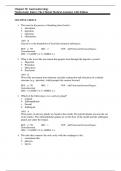Exam (elaborations)
Chapter 34: Gastroenterology Test Bank Kinn’s The Clinical Medical Assistant, 14th Edition Niedzwiecki
- Course
- Institution
- Book
Chapter 34: Gastroenterology Test Bank Kinn’s The Clinical Medical Assistant, 14th Edition Niedzwiecki
[Show more]



